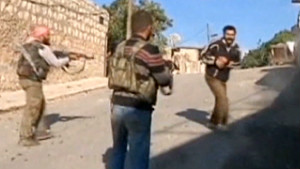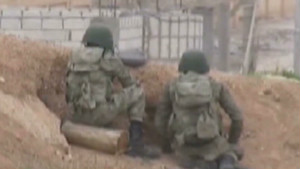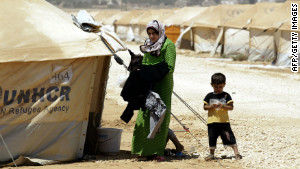(CNN) -- The United States and its allies are gearing up for a new push to unify the Syrian opposition and topple President Bashar al-Assad. They are looking to exploit battlefield gains by the rebels and change the trajectory of the conflict before Syria collapses into a patchwork of local fiefdoms -- and the violence explodes rather than seeps beyond Syria's borders.
With the U.S. election
out of the way and growing concerns about the rise of jihadist groups
within Syria, Western powers are now engaging groups fighting inside
Syria, rather than the exiled and ineffectual Syrian National Council.
The ultimate goal may be to create a safe zone -- a slice of liberated
Syria -- where the opposition can form an interim government.
U.S. and British
diplomats are concerned that over the last year, the initiative has been
yielded to countries like Turkey, Qatar, Saudi Arabia and to "nonstate
actors" from countries like Libya. They have been picking sides among
the diverse brigades of the Free Syrian Army, paying the salaries of FSA
fighters and sending weapons.
There is also great
anxiety about a rapidly worsening humanitarian crisis, with food and
fuel shortages compounded by colder weather and inadequate access to
those most in need.
Here are five signs that the landscape of the Syrian conflict is changing:
1) The U.S. has finally abandoned the Syrian National Council
After 18 months of
internal squabbling and little coordination with groups inside Syria,
the exiled SNC is finally surplus to requirements.
At a news conference
days before the U.S. election, U.S. Secretary of State Hillary Clinton
said: "We've made it clear that the SNC can no longer be viewed as the
visible leader of the opposition. ... That opposition must include
people from inside Syria."
She also disclosed that
the U.S. had helped smuggle out some leaders of the internal opposition
to promote their role. State Department officials say there have already
been contacts with the Free Syrian Army.
British Prime Minister David Cameron chimed in last Wednesday.
"There is an opportunity
for Britain, for America, for Saudi Arabia, Jordan and like-minded
allies to come together and try to help shape the opposition, outside
Syria and inside Syria," he said during a visit to Syrian refugees in
Jordan.
The UK is reviewing whether U.N. sanctions prevent it from supplying weapons to the rebels.
Syrian government denies holding missing journalist, father says
2) The opposition has gotten a makeover
During several days of
meetings in Qatar that ended Sunday, the Syrian opposition only
reinforced its reputation for bickering. At first, the SNC elected a new
executive of 40 members (all men)
with a more Islamist complexion -- a
sign to some observers that it was increasingly a vehicle for the Muslim
Brotherhood. But eventually, after badgering from the Qataris, the
Saudis, the Arab League and Western diplomats, it agreed to join a new
structure that gives activists inside or recently departed from Syria a
bigger say, just as Clinton had demanded.
One driving force behind
the new body -- inelegantly called the National Coalition of the Forces
of the Syrian Revolution and Opposition -- has been Riad Seif, to whom
foreign governments (and especially the United States) look as someone
who can unite the opposition.
Syrian opposition groups reach initial agreement
Seif, a former member of
the Syrian parliament who has spent much of the last decade in jail,
escaped from the country in June. He will be one of two deputies to
Ahmed Moaz al-Khatib, a moderate cleric who was imprisoned several times
by the regime before leaving for Egypt in the summer. The other deputy
is Suhair al-Atassi, a well-known women's rights activist. Her election
to such a prominent role is a signal of the new leadership's secular
complexion.
The Syrian opposition
leadership now has credibility. But the emir of Qatar, who was
instrumental in pushing for the new structure, quickly warned: "This
work has ended, but the next step is more important."
The United States also welcomed the new body.
"We look forward to
supporting the National Coalition as it charts a course toward the end
of Assad's bloody rule and the start of the peaceful, just, democratic
future that all the people of Syria deserve," the State Department said.
Much time has been lost.
The Turkish and Qatari governments have championed rebel brigades close
to the Muslim Brotherhood, and those brigades have emerged as powerful
and independent entities, especially in the north. Washington's hope,
analysts say, is that a broadly representative leadership will regain
control of the opposition without more direct and possibly
counterproductive U.S. involvement.
3) Islamist influence is gaining
Driving the sense of
urgency in Washington, London and Paris is this: The lack of cohesion in
the resistance was, and is, opening up space for jihadist groups such
as Jabhat al Nusra, which has stepped up its campaign of suicide
bombings and joined Free Syrian Army units to capture military bases.
In the most detailed
assessment yet of Islamist factions among rebel groups, the
International Crisis Group reported last month that "the presence of a
powerful Salafi strand among Syria's rebels has become irrefutable."
Al Nusra units are said
to have taken part in the assault on the one of regime's main airbases
in the north at Taftanaz. It's from there that regime helicopters launch
deadly raids across Idlib and Aleppo provinces.
Al Nusra is attracting
recruits because it is better equipped than many FSA factions. Foreign
fighters may number no more than 1,000, but their experience -- in Iraq,
Libya and even Chechnya -- makes them valued recruits. And with the
regime losing control of many border crossings, they can get into Syria
easily.
Writing in Sentinel,
which is published by the Countering Terrorism Center at West Point,
James Denselow says "a marriage of convenience between secular and
Salafi-jihadi fighters against the Bashar al-Assad regime could lead to a
bloody divorce along the lines of the Afghan mujahidin in the 1980s."
Only a more activist
approach by Washington and its European allies will reverse the trend of
lethal aid getting into "the wrong hands" and marginalize Islamist
militant groups.
4) Turkey talks Patriots
To change the dynamics
on the ground, the rebels need a sanctuary within Syria. At some point,
the Free Syrian Army has to control part of Syria if they are to
succeed.
NATO and its individual
members have ruled out enforcing a no-fly zone because of the risk to
aircraft from Syrian missile batteries, which makes the talk by Turkish
officials about installing Patriot missiles along the border with Syria
all the more intriguing.
"No official request has
been made, but talks are continuing as part of contingency plans,"
Turkish Foreign Minister Ahmet Davutoglu said at a news conference
Friday.
NATO Secretary General
Anders Fogh Rasmussen told reporters in Prague, Czech Republic, on
Monday: "If such a request is to be forwarded, the NATO council will
have to consider it."
It's been emphasized in
Ankara that the Patriots would be a defensive deployment in case Syrian
ballistic missiles should be fired into Turkey.
But they could be used
to deter Syrian air power, which has pounded rebel-held territory in
Idlib and Aleppo provinces. While designed to bring down missiles flying
at five times the speed of sound, and with a limited range, Patriots
could certainly threaten Syrian MiGs flying within about 50 miles (80
kilometers) of the border. Missiles can be armed in less than 10 seconds
and reach supersonic speed within a second of being launched.
Turkey mulls defensive measures on Syrian border
5) The regime's grip on northern Syria is slipping
Right now, a buffer zone
within Syria looks most feasible in the northwest, where the Assad
regime has lost wide swaths of countryside along the border with Turkey
and strategic towns. In addition, military bases in Idlib and Aleppo
provinces are under siege or have been overrun, and the regime has lost
control of the main M5 highway that links Damascus and Homs with the
major northern cities.
One example: For almost a
month, rebels have laid siege to a major military base: Wadi al Deif.
It is close to the town of Maraat al Nouman, which sits on the main
highway. Regime forces inside the base have been hanging on, according
to opposition activists, receiving supplies from the air.
Rebel units have also
begun attacking a military airport in Idlib and have cut the road
linking Aleppo with the coast. The regime has responded with more
attacks by air -- many of them indiscriminate bombings of towns the
rebels now hold. Maraat al Nouman and other towns and villages in Idlib
have been devastated.
The number of deaths in
Idlib province more than doubled in October to 720, according to
opposition activists, as the rebels tried to expel government forces
from a wide swath of northwestern Syria.
Better coordination
among rebel units, more reliable supply lines and an improved supply of
weaponry might tip the balance against a regime that is gradually being
worn down by its inability to suppress the insurgency. In recent months,
a pattern has emerged as Syrian forces batter one suburb of Damascus
only to see rebels regroup and surge into another.
That coordination may be
a step closer with the announcement by the Free Syrian Army's military
council that it is restructuring. It is creating five distinct
geographic commands. Mustafa Sheikh, who heads the council, told the
French news agency AFP last week: "We are getting closer and closer to
becoming organized, so that we can get to a stage that is accepted by
the international community."
More critically he added: "When this happens, the international community will know where these weapons are going."
Senior figures within
the FSA are said to be moving from Turkey back into Syria to impose
greater discipline on brigades that are becoming notorious for human
rights abuses.
... But it's late in the day
This injection of
urgency into defeating the Assad regime is unlikely to yield results
before winter, and is it not likely to allow about 400,000 Syrian
refugees the chance to return home. More than 9,000 crossed into Turkey
in one day last week. Cold and hunger could worsen their already
precarious situation, and millions of Syrians still at home are sure to
face shortages of fuel and food.
According to the United
Nations refugee agency, there are at least 1.2 million internally
displaced Syrians and a total of 2.5 million that need help.
Nor will the latest
initiatives soon put a stop to the wholesale destruction across Syria.
From the suburbs of Damascus to the central cities of Homs and Hama to
the heart of Aleppo and Idlib in the north, whole neighborhoods have
been razed. One video posted last Wednesday showed a wrecked school in
Douma, a suburb of Damascus; another set of photographs published in the Atlantic includes scenes reminiscent of Stalingrad or Dresden.
It is extremely
difficult to estimate the cost of reconstruction in Syria -- to repair
homes, schools, hospitals, pipelines and highways, but also to fund
post-revolutionary institutions.
One study by economist
Walid Jadaa, published in September, estimated the cost of the upheaval
so far at $36 billion, which includes lost remittances from Syrians
overseas and an end of tourism as well as physical damage. The Syrian
government recently put the cost of the conflict at $34 billion.
The Syrian Network for
Human Rights has estimated money that nearly 600,000 buildings have been
affected and put the cost of rebuilding or replacing them Money at about $40
billion.
The changes in and
beyond Syria in the last few weeks do not mean the imminent end of the
Assad regime. Perhaps a better way of putting it is to recall how
Winston Churchill described the defeat of Axis forces in North Africa in
November 1942: "Now this is not the end. It is not even the beginning
of the end. But it is, perhaps, the end of the beginning."


























